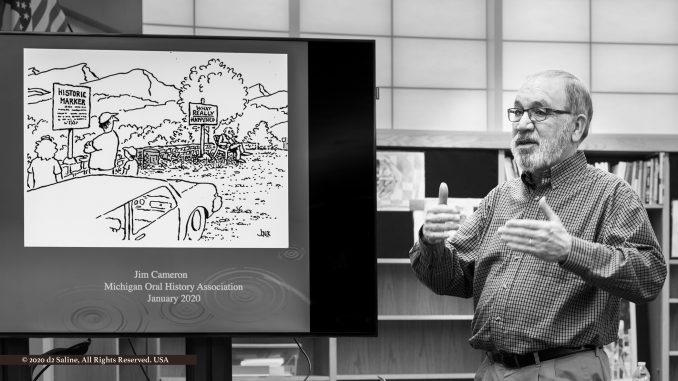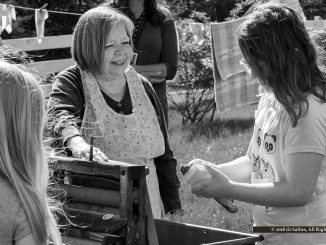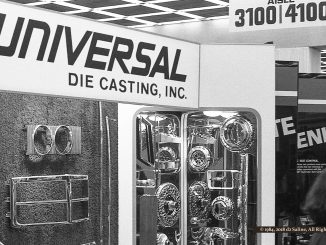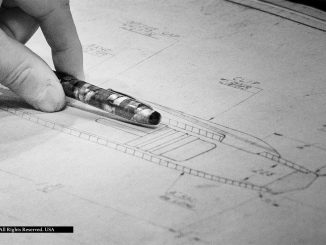
A static image remained set on projection screen as participants gathered for this broad overview of the subject at hand, followed by rather structured how-to application last Saturday.
It was a cartoon giving impression of a scenic roadway pull-off, overlooking mountains and trees. Two adults and a child stood next to a station wagon, as if to underscore cliché, two of them facing a sign headlined: “Historic Marker.” Several more lines of text, indiscernible, appeared below the head — presumably elaborating on that lead.
One member of the party, however, was shown with his gaze cast in a completely different direction. Not far from where he was standing, an older man sat hunched in a chair, legs crossed, staring off at nothing in particular, a curl of smoke emitting from pipe held purposefully between lips.
Behind him, a somewhat less polished sign read, “What Really Happened.” Emphasis on the word “Really.”
As visual supports go, the message behind this one was — for a workshop led by Michigan Oral History Association (MOHA) president Jim Cameron — conspicuously uncertain. Is the sanctioned story told by the formal “Historic Marker” mere fantasy or outright fiction contrived from whole cloth? Or is it simply incomplete, in some measure trivial or somewhat consequential?
It turns out that your answer to what you would see in that cartoon depends a lot on who you are and what you are looking to find.
According to the Oral History Association (OHA), “Oral history is a field of study and a method of gathering, preserving and interpreting the voices and memories of people, communities, and participants in past events.” [2]
Another, impressively blunt examination under the auspices George Mason University casts “oral history” as “a maddeningly imprecise term. [3]
To summarize: Oral history might be understood as a self-conscious, disciplined conversation between two people about some aspect of the past considered by them to be of historical significance and intentionally recorded for the record.
Although the conversation takes the form of an interview, … oral history is, at its heart, a dialogue.
The questions of the interviewer, deriving from a particular frame of reference or historical interest, elicit certain responses from the narrator, deriving from that person’s frame of reference, that person’s sense of what is important or what he or she thinks is important to tell the interviewer. The narrator’s response in turn shapes the interviewer’s subsequent questions, and on and on.
Closer to home, our local touchstone frequently goes to relatively recent initiatives undertaken by Yankee Air Museum to interview original “Rosie The Riveters” for a project with the United States Library of Congress. [4-7]
It’s tempting to think of oral histories in terms of evolution in means of capture, beginning with folklore à la stories passed on from generation to generation before formal writing, the work of Thomas Edison in sound recording and playback, and “The Dawn of Commercial Digital Recording.” Then from there a slippery slope to the next thing — then on to missing the deeply relevant, irreplaceable, and ongoing need to stir and encouage next generations of oral history captures. [8,9]
In a word, Jim Cameron characterized the unique value in their essence of being personal.
Oral histories form a last possible link of intimacy between any given individual and his or her actual roots or roots of interest. Better still, it need not be static. This morning, Mr Cameron shared examples from his own prior career with Saline Area Schools where he used oral histories to connect students with any given decade of study by giving them the assignment of interviewing someone who had actually lived in that period.
He went on to take note of the inherently fleeting nature of these opportunities. An important part of his mission, of the mission of the Michigan Oral History Association, is to connect people with the opportunity to “ask their dads and grandfathers” to “tell their stories” through organized interview processes now, as opposed to “wishing they had” at some later point when exposed to the possibilities here.
Here in this workshop, a forty-five-page spiral-bound MOHA publication titled A Guide For Doing Successful Oral Histories was distributed to attendees in an effort to share best practices for capture, as well as motivate such efforts.
As if providing oversight by proxy, Jim Cameron made his presentation within reach of a Bixby Marionettes Trust display of puppets in the Liberty School board room. During the year-end report by the City of Saline Arts and Culture Committee on its responsibilities for stewardship over the artifacts from the estate of the late Meredith Bixby, he put out an open call to anyone who’d seen those subjects during performances in their day. [10,11]
It was a current, tangible example of how an oral history can help stakeholders, visitors, and historians get as close to this bit of history without breaking glass on the display case.
Or, if you prefer, to get past the “Historic Marker” that anyone might see, to “What Really Happened.”
References
- Next offered: “Oral History Workshop Session B” Calendar (January 29, 2020) Saline Journal.
- Michigan Oral History Association (home page).
- OHA: Oral History Association (home page).
- “What Is Oral History?” History Matters (2018) George Mason University.
- Yankee Air Museum (home page).
- “Yankee Air Musuem wants to hear from ‘Rosies’ for US Library of Congress project” Bryce Huffman (March 28, 2017) Michigan Radio: NPR.
- “Oral History Interviews” The American Folklife Center, Library of Congress.
- “Oral Histories: Resources and Archives: Library of Congress Oral Histories” Rutgers University Libraries.
- “Origins of Sound Recording: The Inventors” National Park Service.
- “The Dawn of Commercial Digital Recording” Thomas Fine (2008,2015) ARSC Journal XLVI (Association for Recorded Sound Collections, Audio Engineering Society.
- “Bixby Marionettes Trust” Saline.
- “Year-end report on Bixby Marionette Trust disposition outlined steady, important forward progress” Dell Deaton (December 11, 2019) Saline Journal.



